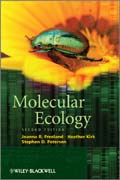
This second edition provides an accessible introduction to the many diverse aspects of this subject. The book unites theory with examples from a wide rangeof taxa in a logical and progressive manner, and its straightforward writing style makes subjects such as population genetics and phylogenetics highly comprehensible to its readers. The first part of the book introduces the essentialunderpinnings of molecular ecology and opens with a review of genetics and a discussion of the molecular markers that are most frequently used in ecological research. The second half of the book then moves on to specific applicationsof molecular ecology, covering phylogeography, behavioural ecology and conservation genetics. The final chapter looks at molecular ecology in a wider context by using a number of case studies that are relevant to various economic andsocial concerns, including wildlife forensics, agriculture and overfishing. INDICE: 1 Molecular Genetics in Ecology What is Molecular Ecology? The Emergence of Molecular EcologyProtein allozymesAllozymes as genetic markers An Unlimited Source of DataMutation and recombinationIs genetic variation adaptive?Polymerase chain reactionGetting data from PCRReal-time PCROverview Chapter Summary Useful Websites and Software Further Reading Review Questions 2 Molecular Markers in Ecology Understanding Molecular Markers Modes of InheritanceNuclear versus organelleHaploid chromosomesIdentifying hybridsUniparental markers: A cautionary note Molecular MarkersCo-dominant markersDominant markers Overview Chapter Summary Useful Websites and Software Further Reading Review Questions 3 Genetic Analysis of Single Populations Why Study Single Populations?What is a population? Quantifying Genetic DiversityHardy-Weinberg equilibriumEstimates of genetic diversityHaploid diversityChoice of marker What Influences Genetic Diversity?Genetic driftWhat is effective population size?Quantifying censuspopulation sizeQuantifying effective population sizeDemographic influences onNeNe, genetic drift and genetic diversityPopulation bottlenecksFounder effects and invasive speciesNatural selectionThe major histocompatibility complexReproduction Overview Chapter Summary Useful Websites and Software Further Reading Review Questions 4 Genetic Analysis of Multiple Populations Why Study Multiple Populations? Quantifying Population SubdivisionGenetic distanceF-statisticsInterpreting FSTNon-a priori identification of populations Quantifying Gene FlowDirect methodsIndirect methodsAssignment tests What Influences Gene Flow?Barriers to dispersalLandscape geneticsMetapopulationsInterspecific interactionsHybridization Population Differentiation: Genetic Drift and Natural SelectionGene flow and genetic driftGene flow and local adaptation Overview Chapter Summary Useful Websites and Software Further Reading Review Questions 5 Studying Ecologically Important Traits: Ecogenomics, QTL Analysis, and Reverse Genetics Studying Ecologically Important TraitscDNA libraries and ESTsMicroarraysHow do microarrays work?ProbesVerifying differences in gene expressionMicroarray applicationsMicroarrays and community ecology of microorganismsMicroarrays and genotyping Connecting Genotype to PhenotypeReverse genetics QTL AnalysisLinkage mappingQTL mappingQTL mapping of ecologically important traits Overview ChapterSummary Useful Websites and Software Further Reading Review Questions 6 Phylogeography What is Phylogeography? Molecular markers in phylogeographyOrganelleversus nuclear markersRepetitive versus non-repetitive markers Molecular Clocks Bifurcating Trees The CoalescentApplying the coalescent Networks NCPA and Statistical Phylogeography The Distributions of Genetic LineagesSubdivided populationsDispersal and vicariance Comparative PhylogeographyRegional concordanceContine
- ISBN: 978-0-470-74833-6
- Editorial: Wiley-Blackwell
- Encuadernacion: Rústica
- Páginas: 449
- Fecha Publicación: 15/04/2011
- Nº Volúmenes: 1
- Idioma: Inglés
